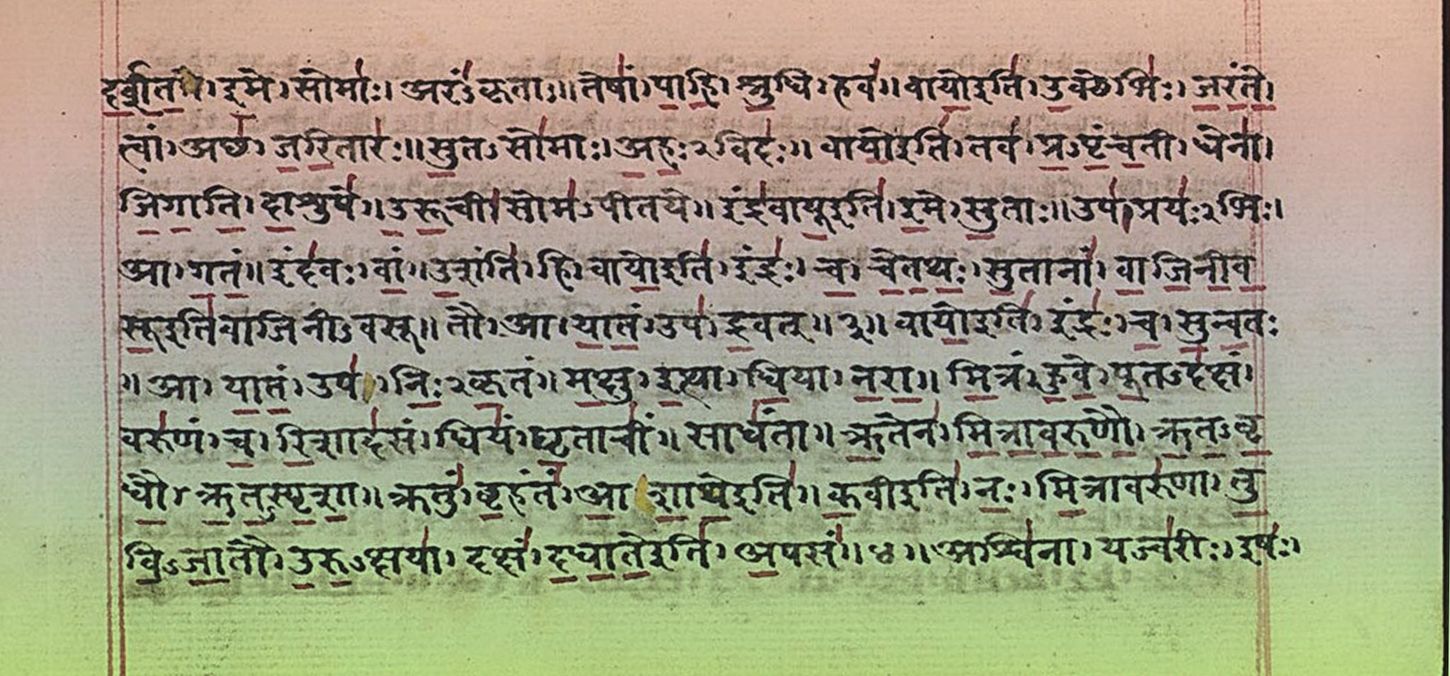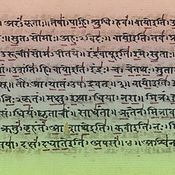
Nun schirren an die Andacht, schirren an den Geist,
Sie, die des großen, weisen Priesters Priester sind;
Die Opfer ordnet er, dem alle Ordnung kund;
Laut wird gepriesen rings im Kreis Gott Savitar.
Paul Deussen - 1897
2 The wise sages of the great sage collect their mind and collect their thoughts. He who alone knows the law (Savitri) has ordered the invocations; great is the praise of the divine Savitri.
Max Müller - 1879
| 2: | This verse is from Taitt. Samh. IV, 1, 1, 1, 4; I, 2, 13, 1, 1; Vâg. Samh. V, 14; XI, 4; XXXVII, 2; Rig-veda V, 81, 1; Sat. Br. III, 5, 3, 11; VI, 3, 1, 16. Saṅkara explains this verse again in the same manner as he did the former verses, while the Satapatha-brâhmana supplies two different ritual explanations. |
Das alte Brahman (Gebet) bring' ich euch in Ehrfurcht;
Weit dringt der Ruf, wie Sonnen ihre Bahn ziehn;
Des Ew'gen Kinder alle ihn vernehmen,
Und die in Wohnungen des Himmels schalten.
Paul Deussen - 1897
1 Your old prayer has to be joined 2 with praises. Let my song go forth like the path of the sun! May all the sons of the Immortal listen, they who have reached their heavenly homes.
Max Müller - 1879
| 1: | For this verse, see Taitt. Samh. IV, 1, 1, 2, 1; Vâg. Samh. XI, 5; Atharva-veda XVIII, 3, 39; Rig-veda X, 13, 1. The Vâgasaneyins read vi sloka etu for vi slokâ yanti; sûreh for sûrâh; srinvantu for srinvanti; and the Rig-veda agrees with them. The dual vâm is accounted for by the verse belonging to a hymn celebrating the two sakatas, carts, bearing the offerings (havirdhâne); most likely, however, the dual referred originally to the dual deities of heaven and earth. I prefer the text of the Rig-veda and the Vâgasaneyins to that of the Taittirîyas, and have translated the verse accordingly. In the Atharva-veda XVIII, 39, if we may trust the edition, the verse begins with svâsasthe bhavatam indave nah, which is really the end of the next verse (Rv. X, 13, 2), while the second line is, vi sloka eti pathyeva sûrih srinvantu visve amritâsa etat. I see no sense in pathyeva sûrâh. Saṅkara explains pathyeva by pathi sanmârge, athavâ pathyâ kîrtih, while his later commentary, giving srinvantu and putrâh sûrâtmano hiranyagarbhasya, leads one to suppose that he read sûreh srinvantu. Sâyana (Taitt. Samh. IV, 1, 1, 2) explains pathyâ sûrâ iva by gîrvânamârga antarikshe sûryarasmayo yathâ prasaranti tadvat. The same, when commenting on the Rig-veda (X, 13, 1), Says: pathyâ-iva sûreh, yathâ stotuh svabhûtâ pathyâ parinâmasukhâvahâhutir visvân devân prati vividham gakkhati tadvat. Mahîdhara (Vâg. Samh. XI, 5) refers sûreh (panditasya) to slokah, and explains pathyeva by patho 'napetâ pathyâ yagñamârgapravrittâhutih. |
| 2: | Yugé cannot stand for yuñge, as all commentators and translators suppose, but is a datival infinitive. Neither can yuñgate in the following verse stand for yuṅkte (see Boehtlingk, s. v.), or be explained as a subjunctive form. A. reads adhirudhyate, B. abhirudhyate, with a marginal note abhinudyate. It is difficult to say whether in lighting the fire the wind should be directed towards it, or kept from it. |



 Dr. Ronald Steiner
Dr. Ronald Steiner
 Nils Jacob Liersch
Nils Jacob Liersch

Nachrichten und Bewertungen